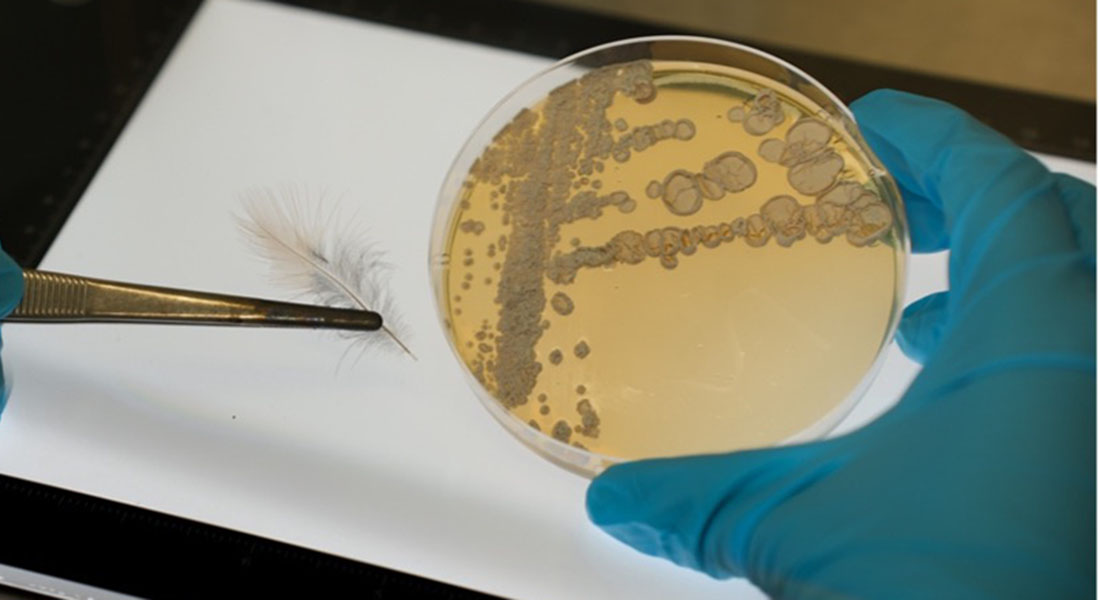Potent antimicrobials from bacteria in toxic birds

The New Guinean Regent Whistler, or Pachycephala schlegelii in Latin, is a strange bird. As a poisonous shield against predators, the whistler carries batrachotoxin in its black and yellow plumage: a potent neurotoxin, also used by poison dart frogs. However, the researchers found that their plumage also carry feather-protective substances, defending it against microbial infestations. These substances are produced by symbiotic bacteria and get secreted from a gland based by the birds’ tail.
While studying these symbiotic bacteria, which belong to the genus Amycolatopsis, previously unknown bioactive substances including two brand new classes of natural products were discovered, along already known antibiotics.
PhD student and first author of the study, Elena Seibel from the Helmholtz Centre for Infection Research explains:
- “Where different organisms live together, there are always interactions. In the case of microorganisms, this communication takes place with the help of chemical signals.”
Natural products discovered in this way not only help to better understand the interaction between two organisms but can also contribute to the development of new anti-infectives.
The research group used co-cultivation studies and cell-based assays, to investigate the antimicrobial effects of the substances produced by the bacteria. Maybe not surprisingly, the new compounds were particularly active against bacteria and fungi that attack the skin and feathers of birds. - “This finding was exciting, since it allowed us to investigate all the steps from getting symbiotic bacteria growing in culture, to understanding their role with the birds, to unravelling the underlying biochemistry conferring these symbiotic benefits”, says Michael Poulsen, Professor at the Department of Biology, University of Copenhagen.
- “This extensive work provides new insights into how bacterial symbionts play defensive roles for bird hosts, while underlining the grand potential in investigating symbiotic bacteria in the search for novel natural products ”, says Kasun Bodawatta, postdoc at Globe Institute, University of Copenhagen. Kasun originally isolated the bacterium from the birds while being on field work in Papua New Guinea during his PhD work at the Natural History Museum of Denmark, University of Copenhagen.

By combining genetic and structural analyses, the team could decipher the genetic blueprints responsible for the production of these natural products and thus confirm their origin in the symbiotic relationship between bird and bacterium. The identification of such bioactive natural products has far-reaching significance, particularly in view of the increasing spread of antimicrobial resistance.
PAPER: Bacteria from the Amycolatopsis genus associated with a toxic bird secrete protective secondary metabolites
“BEHIND THE PAPER” blog post: Unravelling the bioactive potential of a bacterial symbiont of a tropical bird
Research team
The international team was led by Elena Seibel and Christine Beemelmanns from the Helmholtz Centre for Infection Research (HZI) and Saarland University and includes, among others, Kasun H. Bodawatta and Knud A. Jønsson from the Natural History Museum of Denmark and Michael Poulsen and Robert Murphy from the Department of Biology. Sample collection was in collaboration with researchers at New Guinea Binatang Research Centre in Papua New Guinea (Gibson Maiah) and the Papua New Guinea National Museum and Art Gallery (Bulisa Iova).
Contact
Professor Michael Poulsen
Section of Ecology and Evolution
mpoulsen@bio.ku.dk
+45 5394 9311
Sidsel Henriksen
PR & Communication
sidsel.henriksen@bio.ku.dk
+45 29707092
